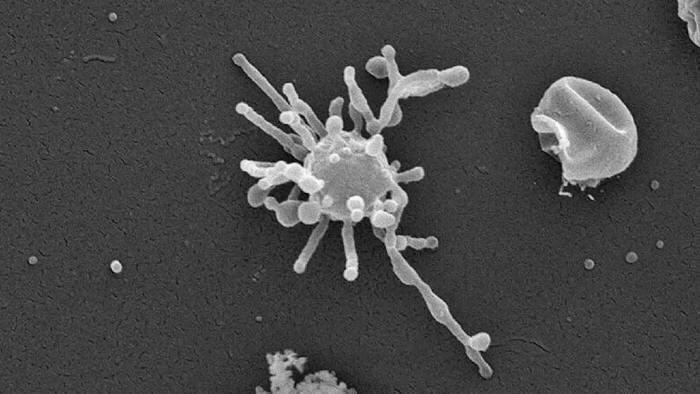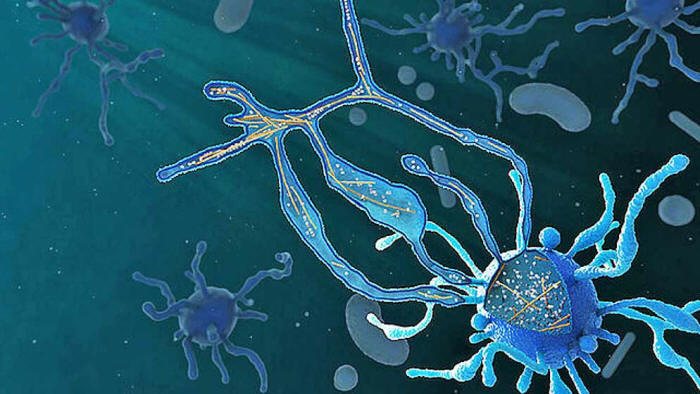|

by Loukia Papadopoulos
December 25,
2022
from
InterestingEngineering Website

Lokiarchaeum ossiferum
under
cryo-electron microscope.
University of Vienna
It is a
member of
the Asgard
archaea...
One of the big mysteries in the field of biology is how the complex
organisms that roam the Earth first arose.
Now, a
collaboration between the working groups of Christa Schleper
at the University of Vienna and Martin Pilhofer at ETH Zurich
may have found the answer, according
to a press release by the first institution published on
Wednesday.
"The
researchers succeeded in cultivating a special archaeon and
characterizing it more precisely using microscopic methods.
This member of
the Asgard archaea exhibits unique cellular characteristics and
may represent an evolutionary 'missing link' to more complex
life forms such as animals and plants," stated the press
release.
Three major domains
On Earth, all
living things are divided into three major domains:
eukaryotes, bacteria, and
archaea.
Animals, plants,
and fungi are all eukaryotes featuring cells that are usually much
larger and more complex than those of bacteria and archaea.
"The genetic
material of eukaryotes, for example, is packaged in a cell
nucleus and the cells also have a large number of other
compartments.
Cell shape and
transport within the eukaryotic cell are also based on an
extensive cytoskeleton," explained the statement.
Scientists today
may understand how these complex cells operate but they still can't
pinpoint how the evolutionary
leap that led to them came about.

The cellular structure
of a newly cultured Asgard archaeon.
University of Vienna
Most current
theories speculate that archaea and bacteria played a central role
in this process.
It is largely
believed that it was a close symbiosis between archaea and bacteria
about two billion years ago that led to the evolution of a
eukaryotic primordial cell.
"In 2015,
genomic studies of deep-sea environmental samples discovered the
group of the so-called 'Asgard archaea', which in the tree of
life represent the closest relatives of eukaryotes.
The first
images of Asgard cells were published in 2020 from enrichment
cultures by a Japanese group," further stated the press release.
Schleper's working
group has now succeeded for the first time in cultivating a
representative of this group in higher concentrations from marine
sediments on the coast of Piran, Slovenia.
The ETH researchers
in Pilhofer's group then used a modern cryo-electron microscope to
take pictures of shock-frozen cells from the group and found that
they contained an extensive network of actin filaments thought to be
unique to eukaryotic cells.
"This suggests
that extensive cytoskeletal structures arose in archaea before
the appearance of the first eukaryotes and fuels evolutionary
theories around this important and spectacular event in the
history of life," further stated the press release.
A newly-discovered
organism
The researchers
called the newly-found organism Lokiarchaeum ossiferum
(pictured).
Now, the scientists
hope to use the new imaging methods to further investigate the
interactions between Asgard archaea and their bacterial partners as
well as basic cell biological processes such as cell division.
"It has taken
six long years to obtain a stable and highly enriched culture,
but now we can use this experience to perform many biochemical
studies and to cultivate other Asgard archaea as well,"
concluded Schleper.
The study was
published in the journal Nature.
Study abstract
Asgard archaea
are considered to be the closest known relatives of eukaryotes.
Their genomes
contain hundreds of eukaryotic signature proteins (ESPs), which
inspired hypotheses on the evolution of the eukaryotic cell.
A role of ESPs
in the formation of an elaborate cytoskeleton and complex
cellular structures has been postulated, but never visualized.
Here we
describe a highly enriched culture of 'Candidatus Lokiarchaeum
ossiferum', a member of the Asgard phylum, which thrives
anaerobically at 20°C on organic carbon sources.
It divides
every 7-14 days, reaches cell densities of up to 5 × 107 cells
per ml and has a significantly larger genome compared with the
single previously cultivated Asgard strain
7.
ESPs represent five percent of its protein-coding genes,
including four actin homologues.
We imaged the
enrichment culture using cryo-electron tomography, identifying
'Ca. L. ossiferum' cells on the basis of characteristic
expansion segments of their ribosomes.
Cells exhibited
coccoid cell bodies and a network of branched protrusions with
frequent constrictions.
The cell
envelope consists of a single membrane and complex surface
structures. A long-range cytoskeleton extends throughout the
cell bodies, protrusions and constrictions.
The twisted
double-stranded architecture of the filaments is consistent with
F-actin.
Immunostaining
indicates that the filaments comprise Lokiactin - one of the
most highly conserved ESPs in Asgard archaea.
We propose that
a complex actin-based cytoskeleton predated the emergence of the
first eukaryotes and was a crucial feature in the evolution of
the Asgard phylum by scaffolding elaborate cellular structures.
|



